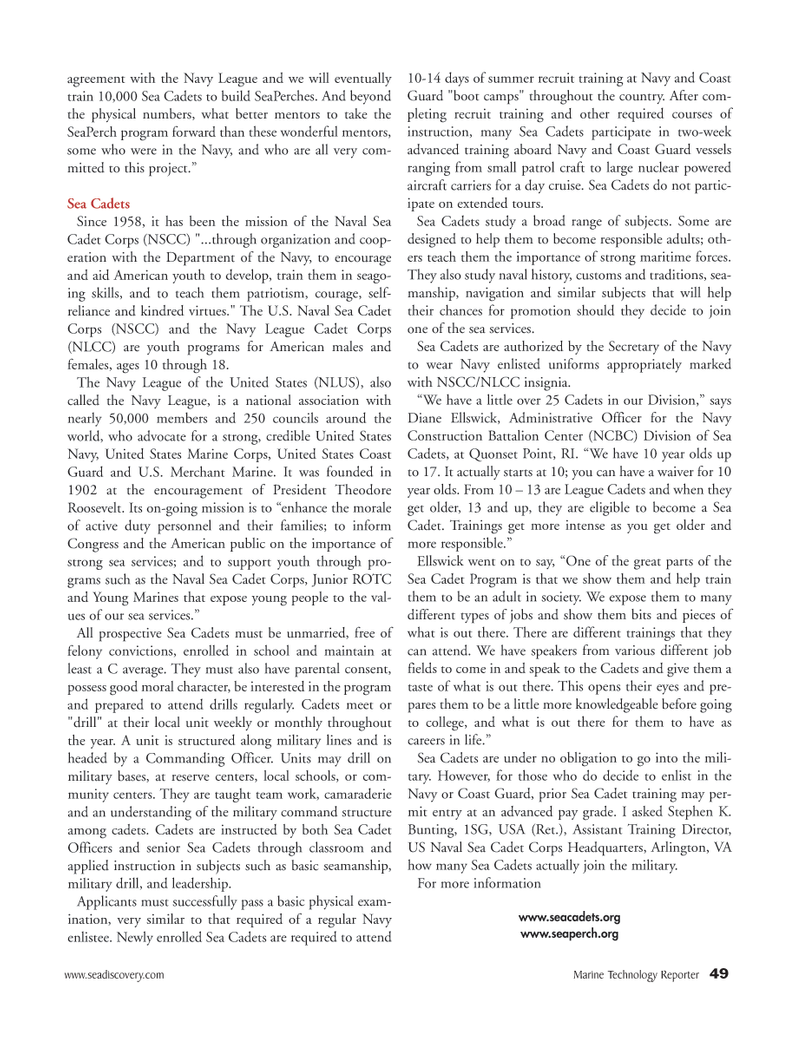
Page 49: of Marine Technology Magazine (May 2012)
Hydrographic Survey
Read this page in Pdf, Flash or Html5 edition of May 2012 Marine Technology Magazine
www.seadiscovery.com Marine Technology Reporter 49agreement with the Navy League and we will eventually train 10,000 Sea Cadets to build SeaPerches. And beyond the physical numbers, what better mentors to take theSeaPerch program forward than these wonderful mentors, some who were in the Navy, and who are all very com- mitted to this project.? Sea Cadets Since 1958, it has been the mission of the Naval Sea Cadet Corps (NSCC) "...through organization and coop-eration with the Department of the Navy, to encourage and aid American youth to develop, train them in seago- ing skills, and to teach them patriotism, courage, self-reliance and kindred virtues." The U.S. Naval Sea Cadet Corps (NSCC) and the Navy League Cadet Corps (NLCC) are youth programs for American males and females, ages 10 through 18. The Navy League of the United States (NLUS), also called the Navy League, is a national association with nearly 50,000 members and 250 councils around the world, who advocate for a strong, credible United States Navy, United States Marine Corps, United States Coast Guard and U.S. Merchant Marine. It was founded in 1902 at the encouragement of President Theodore Roosevelt. Its on-going mission is to ?enhance the morale of active duty personnel and their families; to inform Congress and the American public on the importance of strong sea services; and to support youth through pro- grams such as the Naval Sea Cadet Corps, Junior ROTC and Young Marines that expose young people to the val- ues of our sea services.? All prospective Sea Cadets must be unmarried, free of felony convictions, enrolled in school and maintain at least a C average. They must also have parental consent, possess good moral character, be interested in the program and prepared to attend drills regularly. Cadets meet or "drill" at their local unit weekly or monthly throughout the year. A unit is structured along military lines and is headed by a Commanding Officer. Units may drill on military bases, at reserve centers, local schools, or com- munity centers. They are taught team work, camaraderie and an understanding of the military command structure among cadets. Cadets are instructed by both Sea Cadet Officers and senior Sea Cadets through classroom and applied instruction in subjects such as basic seamanship, military drill, and leadership. Applicants must successfully pass a basic physical exam- ination, very similar to that required of a regular Navy enlistee. Newly enrolled Sea Cadets are required to attend 10-14 days of summer recruit training at Navy and Coast Guard "boot camps" throughout the country. After com- pleting recruit training and other required courses of instruction, many Sea Cadets participate in two-week advanced training aboard Navy and Coast Guard vessels ranging from small patrol craft to large nuclear powered aircraft carriers for a day cruise. Sea Cadets do not partic- ipate on extended tours.Sea Cadets study a broad range of subjects. Some are designed to help them to become responsible adults; oth- ers teach them the importance of strong maritime forces. They also study naval history, customs and traditions, sea- manship, navigation and similar subjects that will help their chances for promotion should they decide to join one of the sea services. Sea Cadets are authorized by the Secretary of the Navy to wear Navy enlisted uniforms appropriately marked with NSCC/NLCC insignia. ?We have a little over 25 Cadets in our Division,? says Diane Ellswick, Administrative Officer for the Navy Construction Battalion Center (NCBC) Division of Sea Cadets, at Quonset Point, RI. ?We have 10 year olds up to 17. It actually starts at 10; you can have a waiver for 10 year olds. From 10 ? 13 are League Cadets and when they get older, 13 and up, they are eligible to become a Sea Cadet. Trainings get more intense as you get older and more responsible.? Ellswick went on to say, ?One of the great parts of the Sea Cadet Program is that we show them and help train them to be an adult in society. We expose them to many different types of jobs and show them bits and pieces of what is out there. There are different trainings that they can attend. We have speakers from various different job fields to come in and speak to the Cadets and give them a taste of what is out there. This opens their eyes and pre- pares them to be a little more knowledgeable before going to college, and what is out there for them to have as careers in life.? Sea Cadets are under no obligation to go into the mili- tary. However, for those who do decide to enlist in the Navy or Coast Guard, prior Sea Cadet training may per- mit entry at an advanced pay grade. I asked Stephen K. Bunting, 1SG, USA (Ret.), Assistant Training Director, US Naval Sea Cadet Corps Headquarters, Arlington, VA how many Sea Cadets actually join the military. For more information www.seacadets.org www.seaperch.org MTR#4 (34-49):MTR Layouts 4/27/2012 9:48 AM Page 49

 48
48

 50
50
